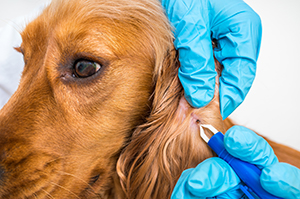IT’S FLEA AND TICK SEASON
PREVENTION: WHAT YOU NEED TO KNOW

By Pamela Smythe-Woods
Fleas and Ticks are two of the most common parasites plaguing our beloved housepets, so PET LIFESTYLES MAGAZINE asked Dr. Brett Shorenstein VMD, Medical Director of Abingdon Square Veterinary Clinic (abingdonsquarevet.com) how to recognize fleas and ticks on your pet; the results of a bite or infestation, and the best solutions for prevention and treatment.
 When you spot a tick on your dog, carefully take tweezers to remove it. Ask your vet how to recognize Lyme-disease carrying ticks and what to do if your pet gets infected.
When you spot a tick on your dog, carefully take tweezers to remove it. Ask your vet how to recognize Lyme-disease carrying ticks and what to do if your pet gets infected.RECOGNIZING FLEAS AND TICKS
The most immediately apparent signs of fleas are itchy, irritated skin; hair loss, scabs, flea dirt (dark grains) or even pale gums. Ticks can be found anywhere on the body and they are typically not even noticed by your pet so it is up to you to be vigilant. Ticks are typically found around the face or at the ear base, however, they can be anywhere - even between the toes.
TREATING PREVALENT PARASITES
Treatment for fleas involves your veterinarian administering an oral medication for rapid flea knockdown, monthly prevention indefinitely and then environmental decontamination with vacuuming, washing all bedding and possibly a pet safe exterminator.
Tick treatment: It is important to remove the entire tick appropriately. If a tick is removed in less than 12 hours; most tick-borne diseases will not be transmitted in that period of time. If you are going to remove a tick, it important that the tick is removed completely - use a pair of tweezers and grip as close to your pet’s skin as possible - try to grasp at the neck of the tick and not squeeze the body of the tick as this may release infective organisms such as Lyme disease. Pull up evenly. Make sure the tick’s mouthparts have been removed. Your veterinarian will want to run a blood test for tick-borne disease 4-6 weeks after tick exposure and will advise on treatment as necessary. If any lethargy, limping, loss of appetite is noted after tick exposure - see your veterinarian as this may signify a tick-borne disease.
 Dr. Brett Shorenstein of Abingdon Square Vets tells us how to keep our pets safe and healthy this Summer by preventing fleas and ticks.
Dr. Brett Shorenstein of Abingdon Square Vets tells us how to keep our pets safe and healthy this Summer by preventing fleas and ticks.BEST WAYS TO PREVENT
We recommend year-round flea and tick prevention. Speak to your vet about the best option for your pet. This may be in the form of an oral product such as Nexgard, Simparica, Bravecto or a topical such as Frontline or a collar such as Seresto. There are natural prevention choices as well if a holistic approach is preferred, however Dr. Shorestein feels strongly that these products are not powerful enough to deter fleas and ticks. He suggests adhering to your vet’s suggestion for a prescription product. However if you are committed to natural products, Wondercide (wondercide.com) offers a wide aromatherapeutic selection for dogs and cats (also for home or yard) with essences including Peppermint or Lemongrass and Sit Stay Forever (sitstayforever.com) offers organic Neem Oil Spray for dogs.
Be very careful with over-the-counter products which may not be safe for your pet. Products that are safe for dogs are NOT safe for cats, therefore, each species should only use their species-specific preventives. The risks of the veterinary prescribed preventives are low - but the oral products can cause gastrointestinal upset and in RARE circumstances seizure may be seen. Your veterinarian can discuss the risks further based on the specific patient. The topicals and collars can have a local reaction at the site where they are placed, so if you start to see any sign of irritation remove the collar and try an alternative. It is a good idea to completely run your hands through your pet’s fur after time outdoors and be sure to do a tick check after coming inside each night from a tick endemic area.













